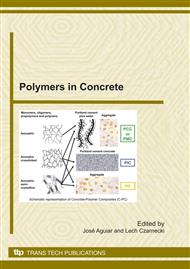p.105
p.115
p.121
p.131
p.141
p.151
p.159
p.167
p.175
Polymer-Modified Mortars for Surface Treatment with the Utilization of Waste Polystyrene
Abstract:
The article is focused on the observation of usable possibilities of waste polystyrene that is created during foundry production and that could be used for production of cellular construction material. Thanks to its granulometry this kind of waste polystyrene is very suitable for use in the fine-soft Polymer-Modified Mortars (PMM), for example in the paste and gluing materials determined for ETICS (External Thermal Insulation Composite Systems). The mixtures for waste polystyrene application feature the required cellular light property, they conform to the requirements on the solidity and adhesiveness and conform also to the tension tests for the reinforcing layer.
Info:
Periodical:
Pages:
141-150
Citation:
Online since:
January 2011
Authors:
Keywords:
Permissions:
Share:
Citation:


